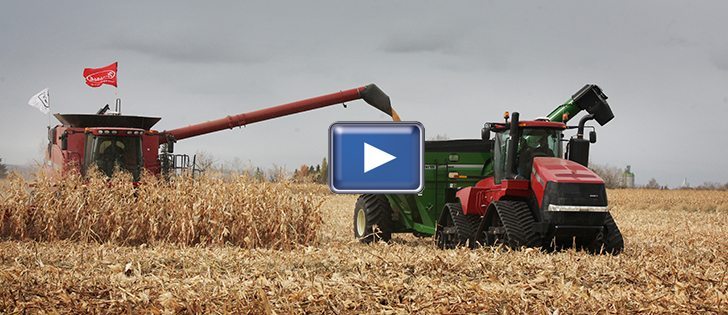NORTH BATTLEFORD, Sask. —Demonstration corn plots are becoming field scale in Western Canada as potential acres reach an estimated 10 million.
Producers and agronomists braved spitting rain and cool fall temperatures last week at North Battleford to observe a grain corn harvest in action.
Debbie Stiles of DuPont Pioneer said her company has been developing shorter season corn hybrids that will fall into the 1,850 corn heat unit range by 2018. Only a few on the market now reach the 2,200 range.
The flint type corn growing on a field behind the North Battleford farm equipment dealership would typically have been used as a forage or silage feed, but it can also be grown for grain. It reached maturity ahead of the first killing frost and had fallen to 30 percent moisture before harvest.
Grain corn harvest would ideally start when the crop falls to 25 percent, but further drying takes a long time this time of the year in the northern Prairies, said Aaron Miller, a Pioneer agronomist from Saskatoon.
Read Also

Russian wheat exports start to pick up the pace
Russia has had a slow start for its 2025-26 wheat export program, but the pace is starting to pick up and that is a bearish factor for prices.
Corn is considered harvestable at 30 percent moisture or lower.
He said producers growing corn, whether in the American Midwest or on the Canadian Prairies, have to be prepared to dry their corn.
According to research by Manitoba Agriculture, standing corn can dry at a rate of 0.3 to 0.5 percentage points per day in October, falling to 0.15 to 0.2 per day in November. Corn at 35 percent Oct.1 might reach 25 percent by the beginning of November and take another month to drop an additional five points.
Farmer’s Edge agronomist Thom Weir said growers should approach their corn with a three-part, staged drying strategy that first puts it on air to ensure it is cool so it resists moulding. The corn then goes through a dryer in two phases: the first taking it down to about 18 percent moisture and the second pulling it down to a more stable 15.5.
Rapid, high heat drying can crack the corn, making it unsuitable for some milling markets, said Weir.
Kevin Hadley of Norsask Farm Machinery set up and ran the combine until rain put a stop to the demonstration.
“The corn header is a little different. It floats on the field and takes off the cobs and a minimum of other material,” he said.
“We ended up setting the combine similar to harvesting peas. Wider concave and slower cylinder speeds. Lots of air and once its set, the crop threshes easily.”
Boyd Risling set up the field scale, 140 acre trial, which began with seeding in mid-May. He said he has clients who are trying corn.
“Generally they have livestock handy to feed, either with grazing or silaging, in case a corn crop doesn’t reach maturity,” he said.
“It’s been pretty successful so far. The market for the grain is either for ethanol or feed milling.”
The North Battleford corn crop was yielding 80 to 120 bushels per acre, according to the combine’s monitor.















